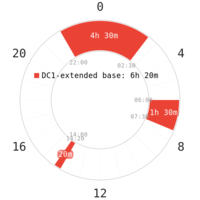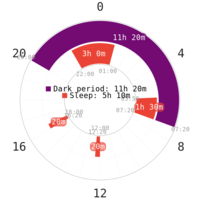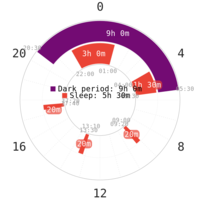Ducamayl
This schedule is a higly flexible schedule derived from the Dual core schedules.[1] Similar to SEVAMAYL, it evolves from adaptation to Dual core schedule such as DC2 and DC3-extended. Unlike with flexed versions of those regular schedules, DUCAMAYL allows taking naps when tired throughout the day, with a varying number of naps and changes in core timings as well as lengths.
| Dual Core As Much As You Like | |
|---|---|
| chart link
Legend
| |
| Total sleep | Undefined, but may average around 5.5-6.5 hours |
| Proposed by | Polyphasic Sleep Discord Community |
| Difficulty | Hard |
| Specification | 2 cores, multiple short naps |
Origin
The name DUCAMAYL stands for “Dual Core As Much As You Like”. It is one of the 4 “-AMAYL'' flexible polyphasic schedules, the other ones being SPAMAYL, SEVAMAYL, and CAMAYL.
Until recently, there has only been one anecdotal success from sleeper Aethermind's father, who has been unintentionally maintaining the schedule for more than 20 years without signs of ill health. His schedule consists of 2 somewhat flexible core sleeps and between 1 and 2 naps in the day.
First created and roughly drafted in 2017 in the Discord, it was proposed as a flexible Dual Core counterpart to SEVAMAYL, a flexible Everyman schedule. In 2020, there have been two more recorded successful adaptations to DUCAMAYL, which are by GeneralNguyen and UncertainBeing.
Mechanism
The mechanism of DUCAMAYL is believed to resemble that of SEVAMAYL, with two shorter cores in place of the long Everyman core.
As with all other Dual core schedules, the first core sleep provides mostly SWS while the second core favors REM sleep, with the nap(s) providing some REM and alertness boosts. Naps can be taken when alertness drops.
After adapting to a rigid base Dual core schedule, the body gets used to the new sleep pattern, which involves 2 core sleeps and a number of naps, as well as the reduced total sleep. Then, the sleeper gradually adapts to flexing, allowing naps to be moved, added, or removed. Because of 2 core sleeps covering much of the night and morning in which the alertness is the lowest, DUCAMAYL tends to have fewer naps than SEVAMAYL.
Scheduling
For average sleepers, the schedule would include at least ~4-5 hours of sleep from the two cores, with about 1-4 naps of 10-20 minutes in length. Nap spacing should take into account natural periods of tiredness, such as the early afternoon circadian dip.
The wake gap between 2 cores can vary on a day-to-day basis. Each core might be flexed or changed in length to some extent. As with SEVAMAYL, it is not recommended to add or remove sleep cycles more than once a week, as either sleep debt or lengthening can destabilize the adaptation to the reduced total sleep. As with all other sleep schedules, should be at least 90-120 minutes awake between sleeps.
A pronap is viable if the whole DUCAMAYL schedule is rotated backward, with the first core being early enough. When necessary, it is also possible to schedule ultrashort naps (~10 minutes) if regular 20-minute nap are too long to schedule. In general, shorter naps contain much less REM. It is suggested that two 15-minute naps can replace one 20-minute nap, after accounting for the time it takes to fall asleep and reach REM.
Adaptation
There has been some attempts at adapting to the schedule cold turkey, but they have virtually all failed. As with SEVAMAYL, first adapting to a strict Dual core base schedule seems to be necessary. The possible base schedules to start from include DC1, DC2, DC2-extended, as well as DC3-extended.
The process of adapting to DUCAMAYL from the rigid base schedule is similar to that of SEVAMAYL. First, one can start with flexing the naps slightly, such as by 30 minutes forward or back. Then, the cores can also be optionally flexed slightly. Over time, one can gradually increase the flexiblility windows of the sleeps. Finally, naps can be added or removed according to the level of tiredness one experiences in a given day.
It is important to do this gradually, however, as flexing all the sleeps right away can destabilise the adaptation. One or both cores of DUCAMAYL can remain fixed, instead focusing on the flexibility of naps for convenience in daily scheduling.
During and after the adaptation, some naps as well as cores may shorten. The best strategy is to get up as long as a good amount of sleep has already been gained since the schedule allows for extra naps later if you get tired.
Difficulty
As Dual core schedules in general are often considered harder than their similar Everyman counterparts, adapting to this schedule may be somewhat more difficult compared to SEVAMAYL. As with other dual core schedules, this depends on whether one is a naturally segmented sleeper.
As with SEVAMAYL, the flexing adaptation will mostly consist of Stage 4-like conditions, feeling somewhat refreshed most of the times, but not always. The adaptation is similarly considered to take several months to complete, in which one needs control of the sleeping environment to maintain the schedule. Overall, despite the relatively mild sleep deprivation, the adaptation to this schedule is considered hard.
Lifestyle considerations
Like other “-AMAYL” polyphasic schedules, people with irregular life schedules greatly benefits from DUCAMAYL. Similar to SEVAMAYL, DUCAMAYL is not very suitable for those on strict work schedules, since the ability to flex naps can be gradually lost if not regularly used. Compared to SEVAMAYL, DUCAMAYL generally requires fewer naps in the day, but involves a second core that may limit early morning activities.
Under emergency or social events, both cores sleeps can be delayed to allow more time awake in the evening. Alternatively, the first core may be skipped, and the second core may be extended by one cycle, though this would incur more sleep debt and be more destabilising. The dark period should change as little as possible to ensure a stable circadian rhythm.
Under normal conditions, dark period should be introduced some time before the first core and maintained in the wake gap between 2 cores like other Dual Core schedules. Because of the potential flexibility of cores, an experienced or well-adapted to flexing sleeper can start the first core 30m or 2-3h after dark period has begun whenever desired. However, excessively delaying the first core should be entirely avoided when adapting and should not be allowed to happen more than once a week or so, to avoid destabilization. This is because the first core’s SWS quality can greatly falter if delayed too often into late night hours.
External factors such as food, exercise and mental health status should be considered carefully and planned accordingly to ensure the quality of each nap. It is generally better to nap before a heavy or long workout, and meals. Otherwise, napping some hours after these activities is also very viable. It is also crucial to manage personal stress levels, as emotional distress is shown to increase REM needs and can put more pressure on the schedule. As an added bonus, the wake gap flexibility between 2 cores allows the schedule to effectively dodge Daylight Saving Time.
Overall, DUCAMAYL is a much more advanced version of a regular Dual Core schedule, with promising flexibility of all sleep blocks and the tenacious ability to sustain performance across the clock. With a usually somewhat high total sleep, it can tolerate certain occasions where the regular sleep hygiene practices have to be temporarily forfeited. The malleability of nap amount and duration from day to day is also highly resilient and convenient to maintain the schedule long term. Another added stronghold is the support and bond between 2 core sleeps - the second core sleep can to some extent fix the inconsistencies and small hiccups from the first core. However, the schedule does offer on average less sleep reduction than SEVAMAYL that proceeds from the very common E3-extended base. While the second core is a great REM stock and mostly safe from real life events, the first core is still vulnerable to evening social hours if done frequently; this is the primary reason that prompts many sleepers to try out Everyman instead.
Like other “-AMAYL” schedules (except SPAMAYL), once adapted it is possible to occasionally extend either core sleep by 90m in the event of slight sickness, somewhat more tiredness, stress or heavy gym workouts. This extension should not be done more than once per 7 or 10 days. Nap durations can also become a lot more versatile on some occasions, being able to be extended to 30m-40m (for early/late morning naps) in experienced sleepers or reduced to 5-10m in the case of emergency that does not allow for the usual 20m, or when it gets late in the day (after ~5:30 PM) to avoid more grogginess upon waking.
Lastly, excessive sleep due to physical recovery, sickness, extended wake periods that promote long sleep, injury, uncontrolled drinking, substance use, etc. can destabilize the whole schedule, which already takes several months to adapt to. With all that said, with thorough planning and execution on all these elements, DUCAMAYL is a powerful schedule to arrive at.
Both core sleeps and the naps will sustain alertness, retain memory, cognitive and ideally physical performance everyday. The ability to gain natural wakes from certain naps or cores is also very satisfying.
Variants
To ensure flexibility of both core sleeps and the naps, the total sleep of both cores combined should be at least 4.5h (e.g, 3h first core and 1.5h second core) and approximately ~5.5h total sleep (all sleeps on schedule). This ideally would cover all SWS and a strong amount of REM sleep and the total sleep of both cores, 4.5h, is comparable with the E3-extended base from SEVAMAYL. However, up to date it is unknown how flexible either core sleep will be with this total sleep, and if one core sleep always has to be stationary. For polyphasic beginners, sleepers with higher sleep needs or those often naturally waking up at night who want a transition to DUCAMAYL, extended base Dual Core versions provide much better opportunities to comfortably flex both core sleeps to some extent. This makes DC1-extended, DC2-extended and DC3-extended good candidates for transitioning to DUCAMAYL.
Aside from these extended variants, modified variants with 2 2.5h core lengths (2.5-2.5), 1 core of 3h followed by a 2.5h core length (3-2.5), or 3.5-1.5 can be scheduled by experienced sleepers or those who know their sleep architecture well enough through the use of a sleep tracking device. Interestingly enough, one DUCAMAYL’s successful adaptation came from Bimaxion base (4h TST) and then the sleeper alternated between 1,2 and 3 naps from day to day. The naps are primarily 30m long as a result of utilizing 30m nap duration (Dymaxion naps). Since this successful adapter was a mutant sleeper (5-6h monophasic requirement), it makes sense that only people with lower sleep requirements would be able to fully adapt to DUCAMAYL with a very low total sleep.
The difference between a 4.5h-1.5h and a 3h-3h combination of both cores can be used for different purposes. For example, a person with higher REM need but lower SWS need can opt for a longer second core and shorter first core, and vice versa. Individuals with heavy training can also pick a longer first core (at least 2 full cycles) for better physical recovery. People with higher sleep requirements can also increase the napping frequency (e.g, DC2-extended) to further support REM sleep. Although for the most part, transitioning from DC1 and DC2 bases would prove to be easier to schedule than DC3 bases.
Depending on the base Dual Core schedule of choice, the corresponding DUCAMAYL variant would reflect the amount of naps needed each day in each of those base schedules. For instance, a DC1 sleeper can alternate between 1-2 naps from day to day, a DC2 sleeper would be an average of 2 naps per day (alternating between 1, 2 and 3 naps), and a DC3 sleeper may require an average of 3 naps per day (2-4 naps) or 2-3 naps depending on the core durations of the base schedule.
Unlike a regular Dual Core schedule whose first core usually starts early (e.g, 9-10 PM), on DUCAMAYL the first core can become quite flexible and start at later evening hours on some days (e.g, 11 PM-midnight) as part of the flexible regime. This allows more social evening time if any need arises. Extended variants can also start the first core at late evening hours (~11 PM-midnight) from the very first adaptation step to strict sleep times. The second core, a big perk of DUCAMAYL, can be flexed accordingly and is generally safe from real life interruptions as it is very late into the night. As a result of flexible core sleeps, the wake gap between each core can increase (moving both cores further or delay the second core) or decrease (moving both cores closer or one core closer to the other) freely. This allows for flexible planning or activities during the wake gap depending on days. For example, a busy night with binge-watching entertainments or work can prompt the sleeper to enjoy more of these night hours, while a night with not many useful activities to do is a cue for a shorter night gap.
References
- ↑ GeneralNguyen. "OFFICIAL! New, Flexible Dual Core Polyphasic Pattern Released: Evolution of the Predecessor Segmented Sleep in the Modern Time". Reddit. Retrieved 2020-11-19.


